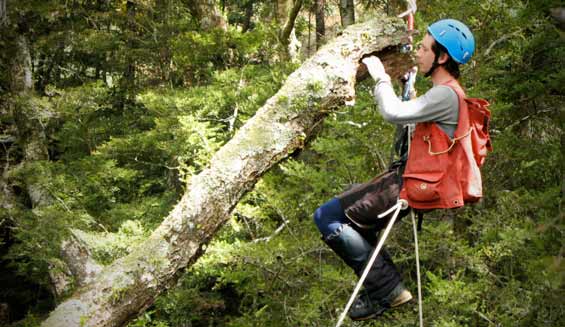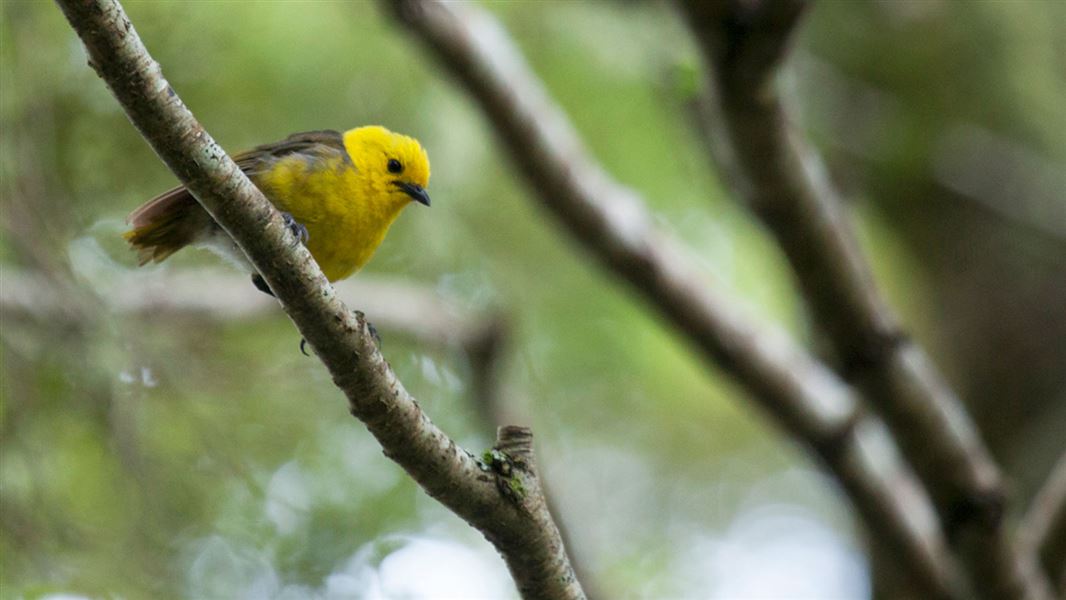Population: Less than 5,000
New Zealand status: Endemic
Conservation status: At risk - Declining
Found in: Small isolated populations in the South Island and Stewart Island/Rakiura
Threats: Habitat loss, predation, competition for food
Sound recording:
Yellowhead/mohua song (MP3, 506K)
00:30 – Adult male song.
Species information: Yellowhead on NZ Birds Online
Image gallery
Mohua conservation
Today, there are about 30 existing populations. They are divided into four groups – those east of the main divide; small scattered Fiordland populations; Southland/Otago hill-country populations; and those on offshore Islands.
Mohua have also been transferred to several predator-free offshore islands, creating new, safe populations – Chetwode and Blumine Islands in the Marlborough Sounds; Breaksea, Chalky, Secretary, Coal, Resolution and Anchor Islands in Fiordland; Ulva Island in Paterson Inlet, Stewart Island and Whenua Hou/Codfish Island.
The populations east of the main divide seem to have suffered the greatest declines. The previously strong population in the Eglinton Valley (in Fiordland) suffered a major collapse in 1999-2001, nearly to the point of local extinction.
This was mostly due to unusually high numbers of ship rats, which preyed upon adults, chicks, and eggs.
However, there are now large-scale predator control programmes in many of the remaining mainland populations. Recently, DOC and our partners have begun returning mohua to these mainland populations, which now have protection, using the island populations as sources.
Did you know?
The mohua is the bird featured on our $100 note.
The decline of mohua
In the 1800s, the mohua was one of the most abundant and conspicuous of our forest birds. Now it is the most threatened of its genus, Mohoua, which also includes the whitehead and the brown creeper. Unlike the other two members of its genus, the mohua has disappeared from large, relatively unchanged forests and is continuing to decline.
With the arrival of Europeans came forest clearances and the introduction of new predators such as rats, stoats and possums. These all had a devastating effect on mohua survival. By 1900, the bird was disappearing from many of its traditional areas.Once mohua inhabited podocarp-hardwood forests (such as rimu, totara and miro). Now they are found only in beech forests with fertile soils where they can find plenty of food.
Although the majority of forests where the mohua live are protected, even within these areas populations are still declining due to predation, forest browsing by possums and deer, and competition with introduced birds. The introduced vespulid wasp also competes with mohua for insects and honeydew and the wasp may have contributed to the bird's disappearance from beech honeydew forests in the northern South Island.
Predator plague and beech masting
The mohua nests in tree holes, making it highly vulnerable to predators like possums, stoats and rats.
A predator plague in 2000 drove the last mohua out of the Marlborough Sounds and caused population crashes in Canterbury, Otago, Southland and Fiordland. Predator plagues caused by high levels of seed production ('beech mast') put mohua at risk again in 2014 as well as 2016.
The ship rat population explosion was likely to have been caused by the occurrence of two beech masting seasons in a row, along with mild winter temperatures in between. This meant the rats had an abundant food supply, with no cold winter to bring numbers down before another bumper breeding season. Stoat control in the valley may also have reduced predation on the increasing rat population.
This double beech mast phenomenon also occurred in other eastern mohua-populated valleys, causing the extinction of the Mount Stokes population, and major declines in the Hawdon, Hurunui and Dart populations.
Those populations in the Southland hill-country seem to be the most stable. These include the Blue Mountains, the Catlins forest and Rowallan/Longwoods forest (near Tuatapere). These forests did not experience the same heavy beech seeding, and so remain under less predation pressure from rats or stoats.
Recovery plan
DOC has established a Yellowhead/mohua Recovery Plan 2002-2012 (PDF, 427K).
Its goal is to maintain and enhance mohua populations throughout their present range and beyond, by halting and reversing the degradation of the forest ecosystem.
The mohua is still accessible to the public in South Island mainland forests and therefore, priority is being given to managing the birds within these forests, mainly through predator control. Such management will also assist other forest birds.

Checking a mohua nest in the Catlins
Predator control
The fortunes of a mohua population in the Eglinton Valley, Southland have been closely followed for the past 30 years by departmental scientists to monitor whether predator control efforts have benefited the birds.
Early results proved that intensive trapping of predators helped the mohua. Without predator control, 50% of nests were preyed upon and breeding females were killed on the nest. Trapping improved nesting success so that over 89% of nests fledged young.
Management of mohua sites involves continuous stoat trapping and occasional use of biodegradable 1080 poison. Monitoring shows that this management has dramatically boosted the population of endangered mohua in the Landsborough Valley in South Westland.
Mohua are being protected as part of our National Predator Control Programme.
Good news
For a threatened species, mohua have a relatively high reproductive rate. Each year they can lay up to four eggs and once these have hatched and fledged the pair can raise another brood. Therefore, if the factors that have caused its decline can be eliminated or reduced significantly, the mohua has a good potential for recovery. Mohua have also bred in captivity at Orana Park in Christchurch.
